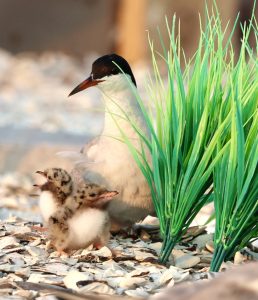
A tern cares for her two offspring on the tern raft, created by the Maryland Coastal Bays Program.
By Cindy Hoffman, Staff Writer
(April 13, 2023) Look out on the water from Hooper’s Crab House or the Cambria Hotel and you can see Skimmer Island, or what remains of it.
The island used to be a prime nesting site for common terns. It was seven acres and high enough that when birds set up nests, high tide did not wipe them out. But the island today is little more than a sandbar because of erosion caused by tidal action, currents and sea level rise.
“There’s not much opportunity for nests there now,” Coastal Bird Conservation Specialist Kim Abplanalp said, of the Maryland Coastal Bays Program.
When the tide is low, small parts of Skimmer Island are still visible, and during the summer, boaters take advantage of that to anchor there.
Many small islands like Skimmer Island, that terns and other birds used to use for nesting, are disappearing, which is one reason why the common tern is not so common anymore. It is designated as endangered in the state of Maryland.
“In 2003, there were 520 pairs of terns, but by 2022, there were only 20 pairs nesting on natural islands,” Dr. Archer Larned, from Maryland Coastal Bays Program, said.
That’s a 90 percent decline in the population.
“One of the main reasons for this decline is loss of nesting habitat,” Abplanalp said.
“They nest on small islands in the Maryland coastal bays. All of these are eroding away due to sea level rise caused by climate change and changes in sentiment dynamics,” Larned said.
“So, we decided to create a raft,” said Abplanalp.
They enlisted the help of Todd Peterson and John Collins to build the raft. Funding came from The Pittman Robertson Fund and Maryland DNR.
In 2021, they built a raft to create an island for terns to nest in Chincoteague Bay west of Assateague Island. The platform consists of different sections, each hinged together to allow flexibility with the tide.
They covered the gaps between the sections with carpet to avoid having chicks slip through and then covered each section with clam shells. Side boards on the platform keep chicks from wobbling off into the water and a ramp down to the water allows the birds to venture out as they fledge.
Solar panels bring power to the platform for cameras, which allows the team to remotely monitor the rafts. Marker lights signal boats that the raft is there.
The platforms’ builders planted fake grass tufts on the rafts. Members of Coast Kids painted small tent shaped shelters for the chicks to protect the birds from predators. The raft is connected to four anchors and has survived winds of up to 60 mph.
A recording of nesting colonies is played to attract terns to the platform.
“These are colonial nesting birds. They want to nest where other terns are,” said Larned.
The platforms’ keepers turn the recordings off at night to avoid attracting predators, such as great horned owls.
The first year resulted in 23 nests with 22 chicks fledged.
This was an 82 percent success rate.
The second year, the platform program expanded to allow for 155 nests, allowing Coastal Bays Program personnel to band 159 chicks.
“We were incredibly thrilled to have this kind of success,” Abplanalp said.
The platform can handle about three times more nests.
“Common terns are astute problem solvers. They figured out quickly how to use the raft and ramp,” Abplanalp said.
A visit to the island can be harrowing for the bird’s human monitors.
“They are able to identify individuals [people] and they will attack some more than others, depending on how frequently we visit them,” Larned said.
Eventually, the team members had to start wearing bike helmets when they were on the platform.
They visit the platform only once a week, to band and check on the birds.
“The raft is very successful as a nesting habitat substitute, but is not a permanent solution.
It would be better to restore natural islands and have natural islands for these birds to nest on,” Larned said.
Long-term plans are to restore sand islands using dredge spoils.
“Talks are underway. But permitting slows that down a little.” Larned said.
“We are working with Ocean City to try to get something set up so if they are dredging a channel, there is a place to put it.” Larned said.
“A lot of things go into it, it’s the whole ecosystem. That takes a lot of cooperation from a lot of agencies,” Abplanalp said.
“We have never been here in history. Never had this situation ever with this kind of sea level rise. We have to adapt quickly. But we have to do it well,” Abplanalp said.
May starts the nesting season, so the raft, hauled out and cleaned of barnacles over the winter, will go out again this week.
“It will be exciting to see how many banded birds show up and how many nests we will get,” Abplanalp said.
